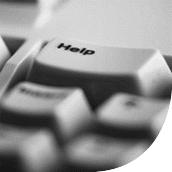Browser basics
Support site help
In order to use the Web effectively, you should have a basic understanding of how to operate your Web browser. The concepts explained here are only the beginning. For more information on your browser, click the program's Help menu and select Contents.
Scrolling
As you will notice, this page seems to cut off at the bottom of your screen. If the information you are viewing seems to continue off the edge or the bottom of your screen like this, you can scroll the page. Look at the right edge of the browser window. You will see a vertical gray bar with arrows at either end. The bar is called the scroll bar, while the arrows are called scroll arrows. If the information on the page extends below the portion visible on your screen, you can "scroll down" to get to it. At the bottom of the scroll bar, click the downward-pointing scroll arrow. The information on the screen moves, allowing you to see a bit farther down the page. To get back to the top, you can click the upward-pointing scroll arrow at the top.
This same idea applies to moving the page from left to right. You will find a very similar horizontal scroll bar along the bottom edge of the window, with scroll arrows pointing left and right. If the words or pictures you're seeing appear to trail off the edge of the window, you can click the left and right scroll arrows to view the rest of the page.
If the scroll bars are unavailable, all the information fits on the screen. Since there is no reason to scroll, the scroll arrows don't do anything when clicked.
Clicking links
Links are what makes the Web such a powerful tool. Clicking a link will take you to another page, another part of the same page, or to a downloadable file. Text links on Gateway's Website look like this (clicking this link won't do anything, it's just an example). Many of the images you see will also act as links, such as the menu on the left side or your screen.
The surest way to spot a link is that your mouse pointer will change its appearance while it hovers over a linked picture or linked text. Links on other sites may look different, but they are always set apart from the rest of the text on a page. Clicking these links will transport you to some other related information.
The BACK and FORWARD buttons
Suppose you click a link, but the page you come to is not what you wanted. Oops. Now you need to get back to where you were. The easiest way to do this is to click your browser's BACK button. At the top of your browser window are a number of controls. One of these buttons is labeled BACK. Clicking the Back button will take you back to the last page you visited. You can continue to go back through all of the pages you have loaded into the browser window. If you go back too far, you can click the FORWARD button, located just to the right of BACK. FORWARD, as you may have guessed, will take you forward again to the next page.
Try it: Click the BACK button. You will be taken back to the page you viewed before this one. Then click the FORWARD button. This will take you back to this page.
Downloading and expanding files
In many cases, you will find driver updates or other files that you may want to download. This sounds simple, but it can be a difficult task for the new Web site user. Click this link to read more about how to download and extract files.
|



